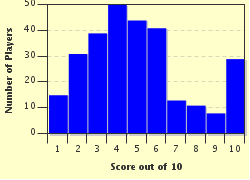Quiz Answer Key and Fun Facts
1. There are several ways of legally obtaining an image for a photo quiz, one of these four is however NOT one that can be accepted on FunTrivia. Which one is it?
2. On the subject of Creative Commons licenses, there are (in version 3.0) four different clauses that can be combined to result in a total of six different license types. Which of the four clauses are permissible for photo quiz images?
3. Especially on Wikipedia and related projects, you may find images that have multiple image licenses listed. The most common example of these is a Creative Commons license combined with the GFDL (GNU Free Documentation License). If this is the case, which of the following is true about your actual rights regarding the image?
4. You have found a picture you want to use and it has a Creative Commons Attribution license. How do you need to credit the author?
5. Moving on to public domain works, there are three major sources where you can reliably find them, i.e. most if not all images are in the public domain. Which of them is NOT a place where you can be certain to find a very high percentage of public domain images?
6. So you now understand the licenses - but it gets worse: Even if the license itself is compatible with the photo quiz rules, you can't use every image. In fact, of the four images shown here (all photographed myself), only one can safely be used without further checking of the legal situation. Which one is it?
7. There will always be some authors (not you, of course) who do not treat the rules seriously and will attempt to pass off a photo they have no rights to as their own. This may initially succeed, but if you get caught, the consequences could be quite severe. Which of the following would NOT be a possible result of an image license violation, if it is the first one you commit?
8. You have uploaded a photo of one of your huskies to an Animals quiz on FunTrivia. Later on, you want to use that image as a prominent part of your kennel's webpage. Can you do so?
9. You have found a nice image licensed under the CC-BY license, but it is not quite what you want. You thus need to apply a few changes in Photoshop. Which of these are you NOT allowed to do?
10. For the grand finale of this quiz, let's take this image. It is a photoshopped composition of three parts - the cat is one of mine (I photographed it), the Statue of Liberty is cut from a Creative Commons image found on flickr.com and the star / galaxy background is a public domain photo from NASA. Which of the license options do I need to pick for this one?
Source: Author
WesleyCrusher
This quiz was reviewed by FunTrivia editor
kyleisalive before going online.
Any errors found in FunTrivia content are routinely corrected through our feedback system.

